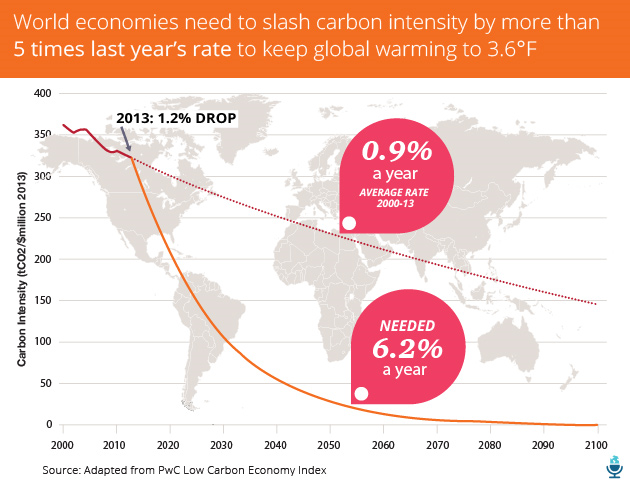PricewaterhouseCoopers estimates the world is 20 years away from climate catastrophe – ‘The gap between what we are doing and what we need to do has again grown, for the sixth year running’
By James West
10 September 2014 (Mother Jones) – With every year that passes, we’re getting further away from averting a human-caused climate disaster. That’s the key message in this year’s “Low Carbon Economy Index,” a report released by the accounting giant PricewaterhouseCoopers. The report highlights an “unmistakable trend”: The world’s major economies are increasingly failing to do what’s needed to to limit global warming to 3.6 degrees Fahrenheit above preindustrial levels. That was the target agreed to by countries attending the United Nations’ 2009 climate summit; it represents an effort to avoid some of the most disastrous consequences of runaway warming, including food security threats, coastal inundation, extreme weather events, ecosystem shifts, and widespread species extinction. To curtail climate change, individual countries have made a variety of pledges to reduce their share of emissions, but taken together, those promises simply aren’t enough. According to the PricewaterhouseCoopers report, “the gap between what we are doing and what we need to do has again grown, for the sixth year running.” The report adds that at current rates, we’re headed towards 7.2 degrees Fahrenheit of warming by the end of the century—twice the agreed upon rate. Here’s a breakdown of the paper’s major findings. The chart above compares our current efforts to cut “carbon intensity”—measured by calculating the amount of carbon dioxide emitted per million dollars of economic activity—with what’s actually needed to rein in climate change. According to the report, the global economy needs to “decarbonize” by 6.2 percent every year until the end of the century to limit warming to 3.6 degrees Fahrenheit. But carbon intensity fell by only 1.2 percent in 2013. The report also found that the world is going to blow a hole in its carbon budget—the amount we can burn to keep the world from overheating beyond 3.6 degrees. The report singles out countries that have done better than others when it comes to cutting carbon intensity. Australia, for example, tops the list of countries that have reduced the amount of carbon dioxide emitted per unit of GDP, mainly due to lower energy demands in a growing economy. But huge countries like the United States, Germany, and India are still adding carbon intensity, year-on-year. [more]
This Legendary Accounting Firm Just Ran the Numbers on Climate Change
